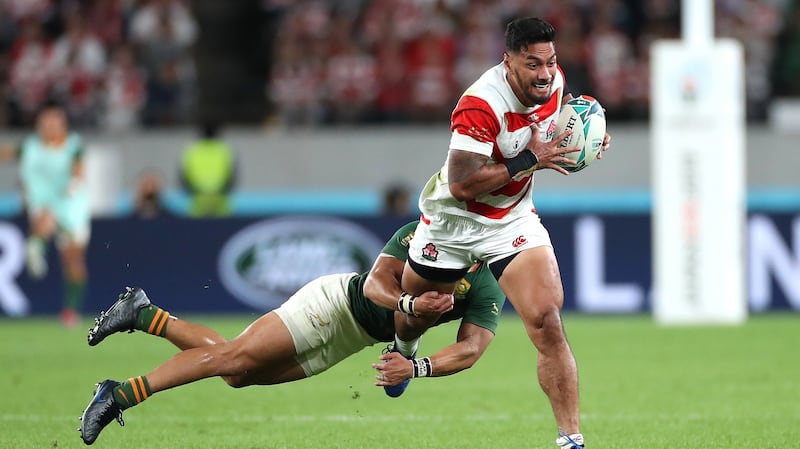The style and substance of Japan's back play invariably draws an eye towards Kotaro Matsushima or most recently Siosaia Fifita, not only twin scourges to opposing defences but players who embody the cosmopolitan heritage of the team.
Clermont Auvergne fullback Matsushima, South African-born to a Zimbabwean father and Japanese mother, is a blur of speed and footwork, sandwiched into a diminutive frame. Tongan-born Fifita, muscular and quick, is more than many a solo defender can manage, as assertion for which several Irish players will vouch.
Fifita, who won his second cap in the summer Test match against Ireland at the Aviva stadium, proved a real handful, characterised in four clean breaks and beating six defenders. However, for the two players to have the scope and space to terrorise opponents there's plenty of work to be done both up front and in the midfield axis, where outside centre Timothy Lafaele is a primary facilitator.
Born in Samoa, he was sent, aged four, to live with an uncle in Auckland. In final year at De La Salle College he received a four-year scholarship to Yamanashigakuin University. It was a bit of a culture shock as he couldn’t speak any Japanese. The rugby too was different from Auckland, long training sessions twice a day punctuated by classes in the middle.
On leaving university he joined the Red Sparks in Fukuoka, followed by the Kolbe Steelers, the Sunwolves in Super Rugby and finally in 2016, the Japanese national side. He made his debut when coming off the bench against Argentina in current head coach Jamie Joseph’s first match in charge. Lafaele has started every game since in winning 25 caps.
A trademark ability to offload out of the tackle is an attribute that he showcased liberally in the 2019 World Cup, one in particular a doozy in the game against Russia, but there were others in the victories over Ireland and Scotland in that tournament.

There was further evidence of that attribute last summer in Dublin, a game in which he scored his seventh try for his country. Ireland has found him a handful on both occasions; he’s carried for over 100 metres in the two games, beaten multiple defenders and made several clean breaks while racking up a try assist to go with the try.
Lafaele confirmed that Japan's expansive, high-tempo style of play is endorsed by coaches and players alike. He explained: "The coaches, Jamie Joseph and Tony Brown, encourage boys to play with their own style.
“It’s [having] good feet; they encourage the boys to have a crack all the time. And it’s in games, not just at training. Having the confidence from the coaches means heaps when you go out to express yourself.
“[Backs coach] Tony Brown, when he takes our backs and we’re doing passing drills, we’ll be doing normal passes and he’ll chuck in, ‘Nah, boys, this time all the passes have to be around the back, keep practising that’. So everyone’s trying it; most guys have one good arm and one bad arm.” Those lines have blurred with the commitment to honing the skill and a willingness to employ it.
Lafaele also name-checked the role that former All Blacks coach Wayne Smith had in his development as a player: "You've got all these other coaches trying to make up moves and stuff but if you run, use hands, you've just got to be square. It's running good lines. It's keeping stuff simple so the boys can understand easily and execute easily," he said of the manner in which Smith communicates with his players.
Lafaele is pivotal to Japan’s attacking fluency. Ireland know this, the challenge is to curtail that threat.


















